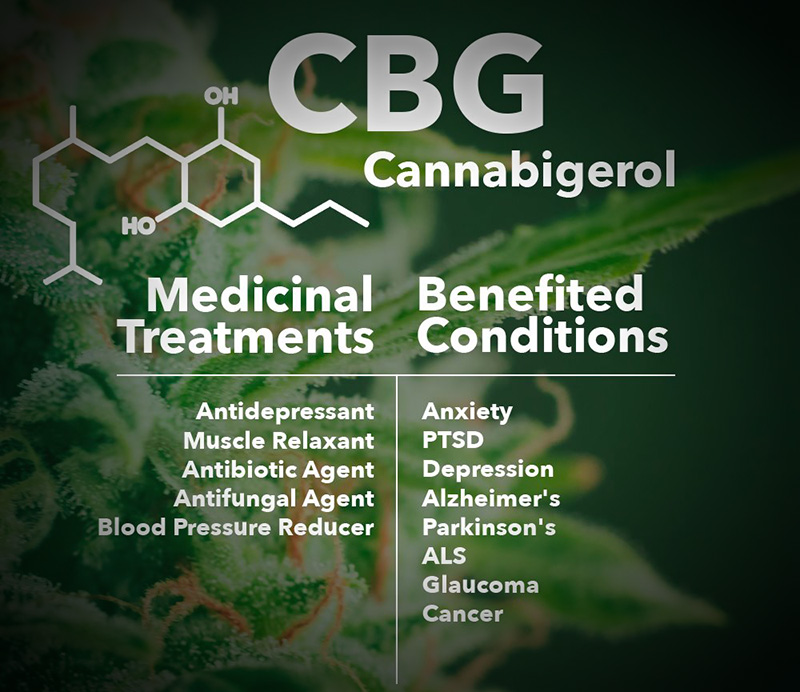Table of Contents
Last Updated on February 22, 2024 by Team Spinfuel

Cannabigerol – Well, that’s a new one…. Or is it?
You may have heard of CBD and THC, two of the most talked-about compounds derived from the cannabis plant. But have you heard of CBG? Short for cannabigerol, CBG is considered the mother of all cannabinoids and the precursor from which other major cannabinoids like CBD and THC originate.
While research on CBG is still in the early stages, preliminary studies indicate it may offer therapeutic benefits similar to CBD and other cannabis compounds. In this article, you’ll learn exactly what CBG is, how it interacts with your body’s endocannabinoid system, and the potential wellness applications scientists are exploring for this intriguing cannabinoid. Understanding the basics of CBG can empower you to make informed decisions about incorporating it into your health and wellness routine.
What Is Cannabigerol (CBG)?
Cannabigerol (CBG) is one of over 100 cannabinoids found in the cannabis plant. Unlike the well-known THC and CBD, CBG is a minor cannabinoid, meaning it is found in very small amounts in most cannabis strains. However, some new cannabis varieties are being bred to contain higher amounts of CBG.
Therapeutic Potential of Cannabigerol
CBG has shown promise for treating a number of medical conditions. It acts as an analgesic, reducing pain and inflammation in the body. CBG also has neuroprotective effects and may slow the progression of neurodegenerative disorders like Huntington’s disease.
Antibacterial Properties
CBG has been found to have antibacterial effects, especially against methicillin-resistant Staphylococcus aureus (MRSA). MRSA is a dangerous staph infection that is resistant to many common antibiotics. CBG’s antibacterial properties could help in developing new treatments for drug-resistant bacterial infections.
In summary, while still a minor cannabinoid, CBG shows significant therapeutic potential. As cannabis research continues to expand, CBG may become more prominently used for its ability to relieve pain, slow neurodegeneration, and combat drug-resistant bacteria.
By selectively breeding cannabis strains higher in CBG, this promising cannabinoid could make its way into more medical cannabis products and treatments.
The Potential Benefits and Uses of Cannabigerol CBG
Neuroprotective Properties
CBG may help protect neurons in the brain and nervous system. Studies show CBG acts as an antioxidant and anti-inflammatory agent in the brain and can help combat degeneration of neurons that leads to conditions like Alzheimer’s and Parkinson’s disease. CBG may also promote the growth of new neural connections in the brain.
Analgesic Effects
CBG appears to interact with receptors in the body that influence pain perception and inflammation. Research indicates CBG may help reduce chronic pain from conditions like arthritis and fibromyalgia. CBG may also enhance the pain-relieving effects of THC and CBD.
Slows Bacterial Growth
CBG demonstrates promising antibacterial properties, particularly against MRSA – a type of staph bacteria that is resistant to many antibiotics. CBG may help reduce infections and shows potential for use as a topical antibacterial agent. More research is still needed, but CBG could provide an all-natural solution to antibiotic-resistant bacterial strains.
Appetite Stimulation and Nausea Reduction
Early research shows CBG may stimulate appetite and reduce nausea. CBG activates receptors in the brain involved in hunger and eating. For individuals with conditions like cancer or HIV/AIDS that experience loss of appetite and wasting, CBG may help increase appetite and caloric intake. The anti-nausea effects could also benefit those undergoing chemotherapy.
In summary, CBG shows promising potential as a therapeutic cannabinoid. Continued research is still needed, but CBG may emerge as an important compound for supporting brain health, managing pain, fighting infections, and improving appetite. When combined with other cannabinoids like THC and CBD, CBG could enhance their effects and health benefits.
 How Does Cannabigerol (CBG) Work in the Body?
How Does Cannabigerol (CBG) Work in the Body?
The Endocannabinoid System
CBG interacts with the endocannabinoid system (ECS), specifically the CB1 and CB2 cannabinoid receptors found throughout the body. The ECS helps regulate many of the body’s functions such as sleep, appetite, pain, and immune system responses. When CBG binds to these receptors, it can influence the ECS and provide therapeutic effects.
Anti-Inflammatory Effects
CBG demonstrates anti-inflammatory properties. Inflammation is a natural immune response, but chronic inflammation can lead to disease. CBG may help reduce inflammation in the body, providing relief from conditions like arthritis and irritable bowel syndrome. CBG’s anti-inflammatory effects could also help improve skin conditions like eczema or psoriasis.
Neuroprotective Benefits
CBG may have neuroprotective effects that help maintain the health and proper functioning of neurological cells in the brain and central nervous system. CBG could help slow or prevent neurodegenerative disorders like Alzheimer’s and Parkinson’s disease. CBG may also enhance the growth of new neural connections in the brain which could help improve memory and cognitive abilities.
Gastrointestinal Support
CBG interacts with the CB1 and CB2 receptors located in the gastrointestinal tract. By binding to these receptors, CBG may be able to reduce inflammation, relieve cramping, and improve appetite. CBG could help alleviate symptoms related to gastrointestinal disorders like Crohn’s disease, ulcerative colitis, and irritable bowel syndrome.
In summary, CBG demonstrates therapeutic potential due to its interaction with the endocannabinoid system and cannabinoid receptors in the body. CBG may provide anti-inflammatory effects, neuroprotective benefits, and gastrointestinal support which could help treat or prevent certain medical conditions and improve wellness.
More research is still needed, but CBG shows promise as an emerging cannabinoid for health and medicine.
Current Scientific Research on CBG
Therapeutic Potential
Cannabigerol (CBG) is currently being investigated for several therapeutic uses in preliminary research studies. CBG acts as an analgesic and anti-inflammatory, which shows promise for chronic pain conditions. It also has neuroprotective effects which could help slow the progression of neurodegenerative diseases like Parkinson’s and Huntington’s.
Appetite Stimulation and Weight Gain
For those struggling with appetite loss or weight gain, CBG may help. Studies show CBG stimulated appetite and weight gain in rats. CBG’s ability to activate CB1 receptors, which regulate appetite and metabolism, likely contributes to this effect. Further research is needed, but CBG could potentially help those with cancer, HIV/AIDS, or other conditions that cause cachexia (muscle wasting and weight loss).
Skin Conditions
CBG possesses antibacterial and antifungal properties which could make it useful for treating skin conditions like acne, eczema, and psoriasis. CBG also reduced inflammation in mice with dermatitis. CBG shows promise as a topical treatment for inflammatory skin disorders and infections. More research is required to determine proper formulations and dosing.
Glaucoma
CBG may help reduce intraocular pressure which contributes to glaucoma. Studies found CBG lowered fluid pressure in the eyes of cats and mice. CBG could potentially provide an alternative treatment to beta-blocker eye drops and oral medications currently used for glaucoma. However, clinical trials are still needed to establish CBG’s safety and effectiveness for glaucoma in humans.
In summary, preliminary research shows CBG has therapeutic potential for chronic pain, neuroprotection, appetite stimulation, skin conditions, and glaucoma. However, larger clinical studies are still needed to determine proper doses, formulations, and applications for human use. CBG appears poised to become an important cannabinoid for medical and wellness applications.
Frequently Asked Questions About CBG
What is CBG and where does it come from?
Cannabigerol (CBG) is one of many cannabinoids found in the cannabis plant. As the plant grows, CBG is converted into other cannabinoids like CBD and THC. As a result, most harvested plants contain little CBG. However, some cultivars have been bred to produce higher amounts of CBG for medicinal use. CBG is showing promise as a therapeutic compound for certain conditions.
How does CBG work?
CBG interacts with the endocannabinoid system in the body, including cannabinoid receptors CB1 and CB2. It is considered a non-intoxicating cannabinoid, meaning it does not produce the “high” associated with THC. Instead, CBG works to maintain homeostasis in the body and support functions like mood, sleep, appetite, and inflammation response.
What are the potential benefits of CBG?
Early research suggests CBG may have therapeutic potential for conditions such as:
- Inflammation and inflammatory bowel disease. CBG may reduce inflammation in the gut and elsewhere in the body.
- Glaucoma. CBG may relieve pressure in the eye that can lead to glaucoma.
- Huntington’s disease. CBG could help protect nerve cells from degeneration, though more study is needed.
- Bacterial infections. CBG has shown antibacterial effects in lab studies and could potentially be used to treat MRSA and other infections.
- Appetite loss and nausea. CBG may stimulate appetite and reduce nausea, suggesting possible benefits for cancer patients and others.
While these initial findings are promising, large-scale clinical trials are still needed to confirm the therapeutic effects of CBG on humans. CBG is considered very safe, but possible side effects include dry mouth, dizziness, and drowsiness.
CBG continues to be an intriguing area of cannabinoid research. Ongoing studies are exploring CBG’s potential for treating additional conditions like colitis, cancer, anxiety, and chronic pain. The future of CBG as a mainstream therapeutic compound looks bright.
Conclusion – Cannabigerol; Real or Just Another Marketing Game
As interest in cannabinoids grows, cannabigerol (CBG) is emerging as a compound with significant therapeutic potential. Research shows CBG may have neuroprotective, antibacterial, and anti-inflammatory properties.
Neuroprotective Effects
CBG may help protect neurons and stimulate neurogenesis. In rodent models, CBG reduced inflammation in the brain and stimulated the growth of new neural connections. These effects could help slow or prevent neurodegeneration from diseases like Alzheimer’s and Parkinson’s.
Antibacterial Properties
CBG exhibits potent activity against a range of bacteria, including methicillin-resistant Staphylococcus aureus (MRSA). MRSA infections are difficult to treat and CBG could offer an alternative therapy. Studies found CBG comparable in potency to traditional antibiotics.
Anti-inflammatory Effects
CBG reduced inflammation in rodent models of inflammatory bowel disease, arthritis, and skin inflammation. By inhibiting the production of inflammatory molecules like nitric oxide, CBG may relieve inflammation in humans. However, more research is needed to confirm these effects and determine appropriate doses.
While research on CBG is promising, many of the potential benefits still need validation in human clinical trials. Companies are marketing CBG as a cure-all before science fully supports these claims. Consumers should be wary of overhyped benefits and look to reputable studies to make informed decisions about CBG products. That said, if future research confirms its therapeutic effects, CBG could become an important tool for relieving inflammation, protecting the nervous system, and fighting infection. For now, CBG remains an intriguing compound with real potential, not just another marketing game.
Conclusion
Your exploration into the therapeutic potential of cannabigerol has led you to a greater understanding of this intriguing cannabinoid. While research is still in early stages, initial studies show promise for CBG’s ability to treat conditions like inflammatory bowel disease, Huntington’s disease, and cancer.
As laws and regulations continue to evolve, broader access will open doors for increased research. Keep an open and discerning mind as we learn more about proper dosing, potential drug interactions, and the most effective delivery methods. Approach cannabigerol not as a cure-all, but as a compound that may complement conventional treatments.
With an educated, balanced perspective, you now have the knowledge to make informed decisions about if and how CBG could benefit your health and wellbeing.









